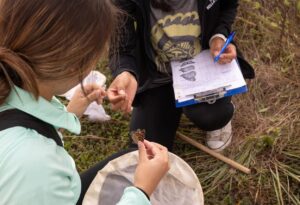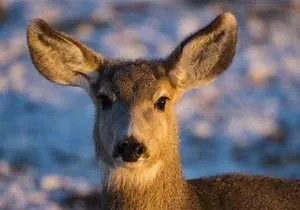Celia Llopis-Jepsen
Kansas New Service
Butterfly enthusiasts in the eastern half of North America will have to look harder this spring and summer to spot the winged migrants that have become an international symbol of insect conservation.
At a news conference in Mexico City on Wednesday, conservation scientists revealed that the second smallest population of monarchs on record reached their overwintering sites in the mountains of south-central Mexico last fall.
Scientists gauge the size of the roosting population in terms of how much forest the clustering butterflies occupy.
The size fell to 2.2 acres this winter, the second smallest since scientists began tracking in this manner in the early 1990s and down from a peak of 45 acres in the mid-1990s. The lowest recorded size was about 1.7 acres in the winter of 2013-2014.
The news could intensify debates among monarch scientists over whether the species deserves federal protection, how much risk the species (or its migration) faces, the size of the species’ population historically and how to increase current numbers.
“A lot of people may see very few this year,” said Kristen Baum, a professor of ecology and evolutionary biology at the University of Kansas. “It could be a rough couple of years.”
Baum directs Monarch Watch, a conservation, education and research program at the Kansas Biological Survey and Center for Ecological Research. It typically distributes more than 350,000 butterfly tags each year to thousands of volunteers across the continent to help study the species’ fall migration.
Baum and other scientists from Mexico, Canada and the U.S. gathered in Mexico City this week to discuss conservation efforts.
There, the Mexican agencies and conservation groups that estimate the size of the famed, eye-popping masses of roosting monarchs revealed that few clustered in fir forests this winter. They occupied about 60% less area than last winter.
Why so few butterflies this winter?
So, how many butterflies are roosting this year? Translating acres of roosting insects to numbers of individuals is tough, but a 2017 study suggests calculating about 21 million butterflies per hectare (2.47 acres). That translates to fewer than 19 million roosting monarchs this year.
Widespread use of agricultural herbicides that kill milkweed, the spread of cities and suburbia, insecticides, parasites, climate change and logging in Mexico all get blamed for declining numbers of migrating monarchs in recent decades. Drought years deal an extra blow.
Last year’s drought along key parts of the migration route, such as Oklahoma and Texas, meant the insects likely struggled on their way south in late summer and fall to find enough flower nectar to complete the journey and survive the winter in the mountains of Mexico, according to Monarch Watch.
The good news: Insect populations can bounce back fairly fast when conditions improve, so roosting numbers could climb a year from now if rainfall and temperatures cooperate.
“That’s kind of the nature of insects,” Baum said. “There is the capacity to build back up.”
Rainfall impacts flower production. Temperatures affect how quickly or slowly eggs develop into adults that can carry the baton northward for the species’ annual migration to the northern U.S. and Canada.
“The thought is, the population will rebound,” Baum said. “But it’s going to take time and it really depends on all those other conditions.”
Monarch fans can’t change the weather, but they can take other steps to support the creatures.
Planting milkweed
Along the monarch’s migration routes, the adult butterflies hunt for the milkweed that lets them lay eggs in the spring and summer. Caterpillars eat the leaves.
Many North American gardeners now embrace milkweed, prompting some cities to drop bans against plants traditionally viewed as weedy. In 2017, the Illinois Legislature struck down all municipal bans on milkweed and made the milkweed genus the state’s wildflower.
In Kansas, Overland Park dropped its ban against common milkweed in November.
Some schools and educational groups can get free milkweed from Monarch Watch, which also offers free milkweed for some large habitat restoration projects.
Planting late-blooming flowers
Adult monarchs must find enough nectar to complete their fall migration and to store energy for the winter months.
Baum suggests adding late-blooming wildflowers to gardens, including some that hold up well in dry conditions. She notes that many native wildflowers fit the bill.
The Missouri Prairie Foundation’s Grownative.org website lists species that thrive in the Midwest and offer nectar in fall, such as goldenrods and asters.
The National Wildlife Federation, Monarch Watch and other groups offer tips and certification or registration programs for creating effective pollinator gardens. Such gardens also support a wide array of pollinators beyond the monarch, such as native bees.
Participating in
citizen science
Citizen science opportunities abound and go beyond fall tagging efforts.
Each spring, for example, people can report their first annual sightings of monarch eggs, caterpillars and adults to Journey North to help document the species’ northbound movement.
“All of those pieces of information are really helpful,” Baum said, “and (it) would be impossible to get that across the whole range with just scientists going out.”
Debates about helping butterflies
A few popular ways of engaging with these butterflies have split the monarch-loving world. This includes disagreement over whether rearing the insects in captivity and releasing them — sometimes in large numbers — helps the species or spreads disease. Planting nonnative, tropical milkweeds to feed monarchs has also divided experts for related reasons.
The federal status of monarchs
Each spring, adult monarch butterflies that survive the winter in Mexico head north.
They lay eggs and die, and their progeny continue north, lay eggs and die. Ultimately the insects reach the northern U.S. and Canada over the course of three or four short-lived generations.
The butterflies then head back to Mexico later in the summer and fall. This last generation of the year lives up to nine months so that it can migrate the entire way to Mexico in a single generation, hunker down for five months of cold and postpone egg-laying until the spring. They overwinter by clustering together in trees to stay warm.
Nonprofit groups and the Mexican government work together each winter to compile an estimate of the overwintering population.
In the winter of 2013-2014, the overwintering population dropped to just under 1.7 acres of roosting butterflies. In 2014, conservation groups and entomologists petitioned the U.S. government to declare the species threatened.
The U.S. Fish and Wildlife Service reviews such petitions. In 2020, it concluded that listing the species as threatened or endangered would make sense. However, the butterfly effectively had to get in line: The agency needed to work through other pending species listings first.
“We will develop a proposed rule to list the monarch butterfly as our priorities allow,” the Fish and Wildlife Service wrote in its findings.
The agency plans to revisit the matter annually.
The International Union for Conservation of Nature considers migrating monarchs “vulnerable” to extinction.
After Wednesday’s announcement that overwintering populations had fallen to a near record low, Monarch Watch founder Chip Taylor called the news “a shock.”
“The depth of this decline is beyond our experience,” he said in a KU news release, but added that numbers have rebounded after past extreme weather events. “This count does not signal the end of the eastern monarch migration.”
A separate population of monarch butterflies exists west of the Rocky Mountains. Its numbers have also plunged in recent decades.
Last month, the Xerces Society for Invertebrate Conservation announced that scientists and volunteers counted about 233,000 of these western monarchs at winter sites primarily in southern California. That’s about 5% of the numbers tallied in the 1980s.

People tag monarchs at Baker University’s Wetlands Discovery Center last September. Monarch Watch holds a tagging event each fall during migration season.
https://www.kcur.org/news/2024-02-07/monarch-butterflies-just-took-a-big-hit-kansans-may-see-few-of-them-this-year




